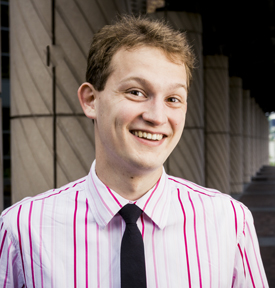Reid Dale is not one to shy away from a challenge. Soon after arriving at the UW as an undergraduate, he began taking graduate-level courses in mathematics and philosophy—and was regularly at the top of the class. That would be impressive for any undergraduate, but consider this: Dale came to the UW at age 15 through the UW’s Early Entrance Program, skipping high school altogether.
“I never wanted to use my age as an excuse,” Dale explains, “but I also didn’t see it as something to be boastful about. It is what it is. I didn't want to sell myself short.” For all his accomplishments, Dale, a mathematics major, is the 2014 Dean’s Medalist in the Natural Sciences. Dean’s Medalists are selected on the basis of academic performance and faculty recommendations.

Professor James Morrow still remembers a capstone paper Dale submitted for an honors math class early on. “His was by far the deepest and most original paper,” recalls Morrow, Barbara Hand Sando and Vaho Rebassoo Term Professor of Mathematics. “It was a complete surprise that a sixteen-year-old student could have written such a sophisticated document.” Since then, Morrow has worked with Dale on areas of common interest and readily admits that he has “benefited from having Reid teach me some things in which he is already an expert.”
When Dale arrived at the UW, he was undecided on a major. A year in the Transition School at the Robinson Center for Young Scholars provided an opportunity to explore all that the UW has to offer. An essay he co-wrote for an English course during his sophomore year earned him and his writing partner the UW’s Andrew Hilen Prize for Outstanding Critical Expository Essay, but despite the writing accolades, he gravitated to mathematics and philosophy. “I’ve always been attracted to abstraction,” he says. “The more abstract a problem, the more it appeals to me. I found that the subject matter and the methodologies of math and philosophy aligned very well with my intuitions.”
Dale explains that his philosophy coursework—mostly in the area of logic—dovetails with his math specialization in mathematical logic. “The area I'm working in is at the border of the two disciplines,” he says, noting that both disciplines approach similar questions, but from a different perspective. “I got a good feel for both sides of the coin.” John Manchak, associate professor of philosophy, lauds Dale as “the best philosophy student, undergraduate or graduate, I have ever had in any class.” Bob Dumas, affiliate assistant professor of philosophy, adds that he was forced to further develop his own knowledge of model theory so that he could present material at Dale’s level of understanding.
I try to ignite a spark in those who might not enjoy math by giving them glimpses of fascinating areas of math they might not otherwise learn about.
Through summer programs at the UW, UCLA, and UC Berkeley, Dale furthered his study of logic and model theory. The Berkeley program, intended for graduate students, led to a close collaboration with Berkeley mathematics professor Thomas Scanlon, who will be Dale’s thesis adviser when he enters the PhD program at Berkeley this fall. In reality, Scanlon began advising Dale earlier this year. “Reid took the bold step of spending the last four months [of his undergraduate career] at Berkeley, working with Scanlon,” says Morrow. “I’ve never heard of an undergraduate being so bold and ambitious.”
While Dale is comfortable collaborating with faculty and advanced graduate students, he also enjoys spending time with budding mathematicians at the elementary and middle school level. He volunteered weekly through two Department of Mathematics outreach programs, Montlake Math Challenge and UW Math Circle, sharing his passion for math with younger students. He also found time to visit his own middle school in Federal Way, Washington, guest lecturing on logic and proofs at the invitation of his former middle school math teacher.

“I feel like I’ve benefited a great deal from having many mentors who have guided me, providing advice and support, and I’d like to be that for other students,” Dale explains. While he enjoys working with students who have an affinity for mathematics, he also welcomes students who are less enamored. “I try to ignite a spark in those who might not enjoy math by giving them glimpses of fascinating areas of math they might not otherwise learn about,” he says.
Dale is particularly interested in encouraging girls to consider studying mathematics, having noticed a striking gender imbalance in his graduate-level mathematics courses. He became aware of this imbalance, he says, in part due to his background in the humanities. “My contact with the humanities has made me more cognizant of the power relationships present in my day-to-day and professional interactions," he says. "These relationships have real consequences and, in particular, affect people's career aspirations. With this in mind, I pay close attention to how I can positively alter these structures of power in the classroom setting.”
With Dale planning a career in academia, that awareness is likely to have a profound effect on those he mentors in the future. He looks forward to encouraging others throughout his career.
“I was incredibly fortunate to have the full support of my family and peers to follow the path I wanted to follow,” he says. “To have such communal support is, unfortunately, not typical. I hope to have the good fortune to continue serving as a mentor to bright, young students who might not have realized that mathematics was an option for them—both during my time as a graduate student at UC Berkeley and beyond.”
More Stories

The Public Impact of Private Cities
Geography major Edwin Bai has researched private cities, developed by individuals and corporations, that "take the libertarian idea of low government regulation to the maximum."

A "gesture" to jump-start careers
To prepare students for professional success, the UW College of Arts and Sciences offers “gesture,” a mock startup company where student interns gain skills that employers seek.

Awards for Research, Social Justice Efforts & More
Recent awards celebrate Arts & Sciences faculty, staff, and alumni for their research, social justice work, lifetime achievements, and more.